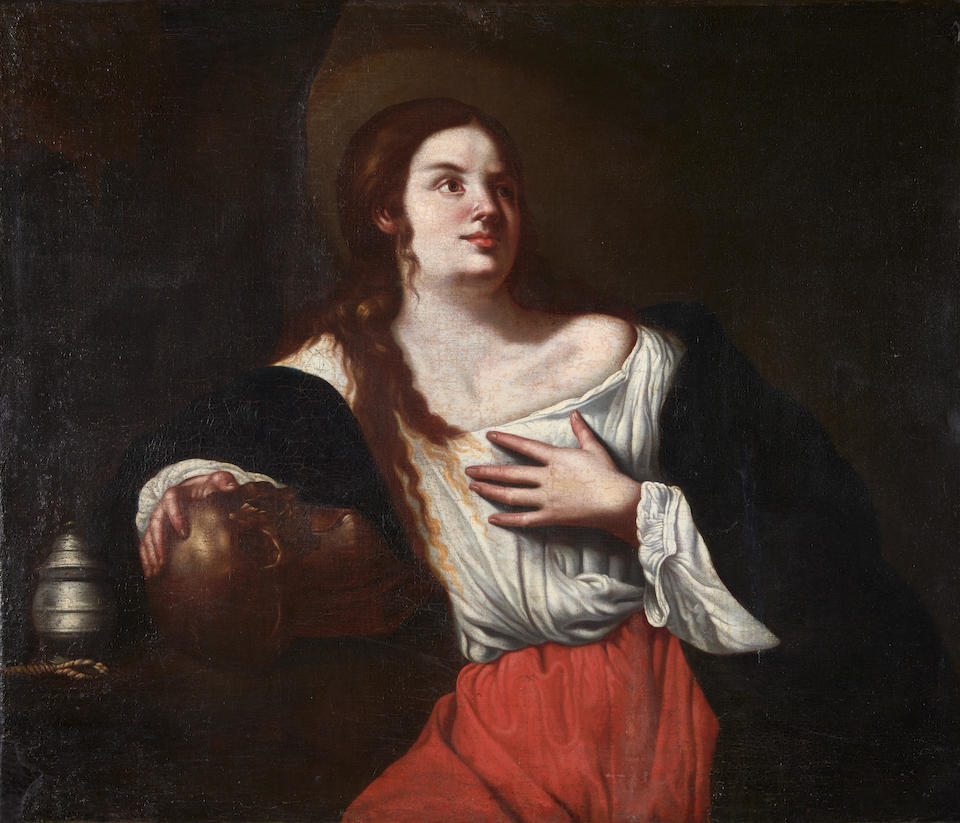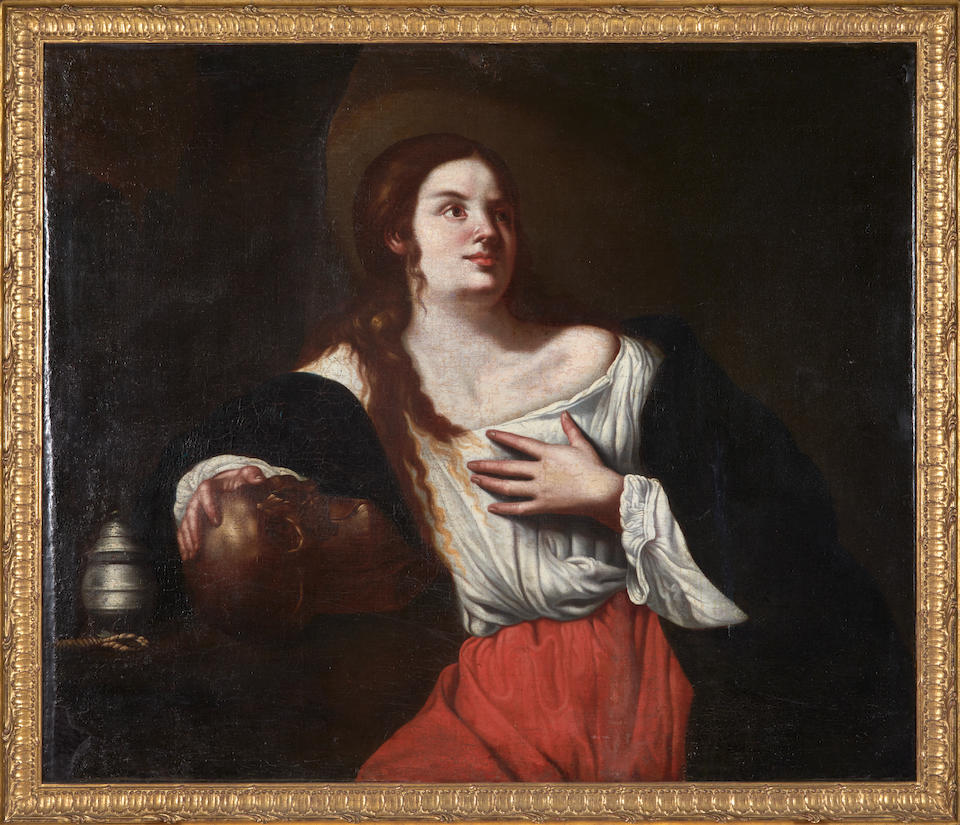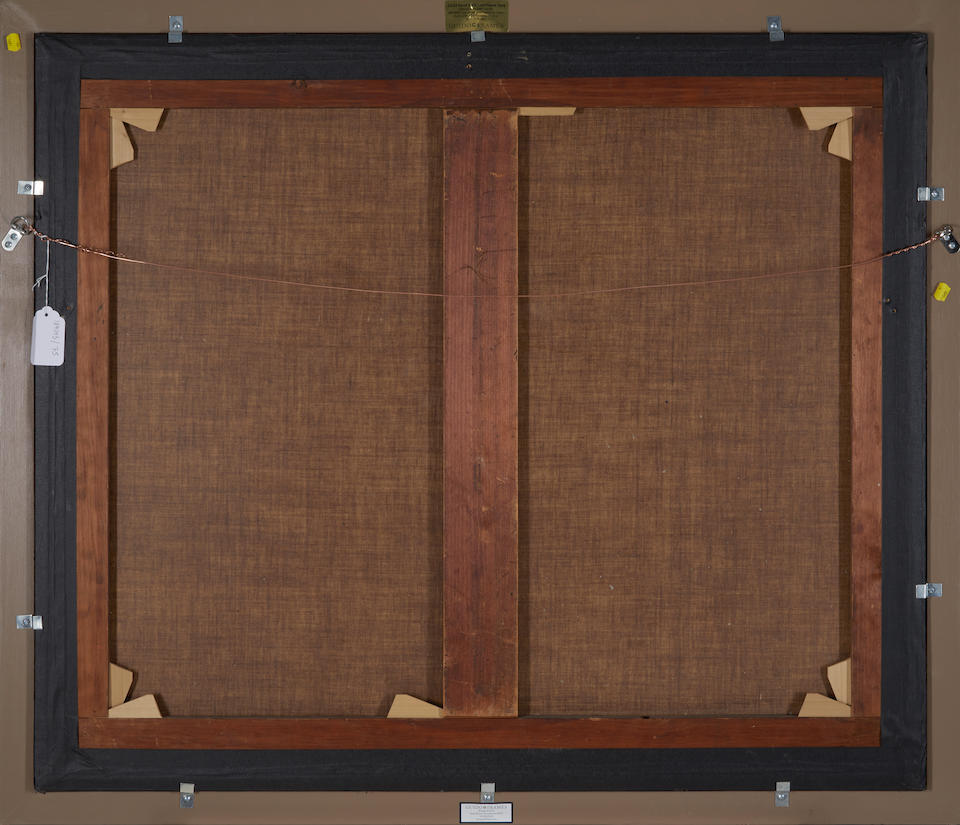1
Italian School (17th century) Penitent Magdalene (framed 98.4 x 114.3 x 3.2 cm (38 3/4 x 45 x 1 ...
In European Art
Italian School (17th century) Penitent Magdalene unsigned oil on canvas 89.5 x 104.6 cm (35 1/4 x 41 3/16 in). framed 98.4 x 114.3 x 3.2 cm (38 3/4 x 45 x 1 1/4 in). Footnotes: N.B. Mary Magdalene is the most frequently mentioned woman in the canonical gospels. Mary likely came from a wealthy family in Magdala, on the shores of the Sea of Galilee in Israel. She traveled with Jesus during his ministry, was present at the Crucifixion, and was the first witness to Jesus's resurrection. Her involvement in the latter two events varies among the gospels but is certainly her most important legacy. A long-standing conflation of four Biblical Marys - Mary Magdalene, Mary of Bethany, Mary of Egypt, and an unnamed 'sinful woman' (Luke 7:36-50) - has led to the common view of Mary Magdalene as a redeemed sinner. This conflation likely began as early as the third century, and began in earnest in 591 with Pope Gregory I: 'She whom Luke calls the sinful woman, whom John calls Mary, we believe to be the Mary from whom seven devils were ejected according to Mark.' In medieval times Mary Magdalene was further conflated with Mary of Egypt, who spent years as a repentant hermit in the desert, wandering until her clothes wore down and fell off. Although the erroneous bases for these conflations have since been corrected, the conception of Mary Magdalene as a redeemed or penitent sinner persists. In the present composition are a number of items associated with the life of Mary Magdalene - in all its iterations. Her flowing hair, red robe, and bare shoulders are all easily identifiable attributes. The ointment jar at the left references Mary Magdalene's conflation with Mary of Bethany, who John says anointed Jesus's feet. The skull is a memento mori often also seen in paintings of Saint Jerome from this period. The rope could be a reference to the ropes that held Mary of Egypt's clothes together in the desert; alternatively, it may be part of a discipline, which was a knotted rope used for self-flagellation. Behind the skull sits an open book, which is another common attribute of Mary Magdalene. The broader composition is typical of the 'Penitent Magdalene' iconography and is clearly related to Mary of Egypt's desert journey: Mary sits alone in a spartan desert landscape, gazing heavenward with repentance and hope. Similar iterations of this iconography have been painted by Titian, José de Ribera, Caravaggio, Carracci, and many more. For further information on this lot please visit Bonhams.com For further information about this lot please visit the lot listing
Italian School (17th century) Penitent Magdalene unsigned oil on canvas 89.5 x 104.6 cm (35 1/4 x 41 3/16 in). framed 98.4 x 114.3 x 3.2 cm (38 3/4 x 45 x 1 1/4 in). Footnotes: N.B. Mary Magdalene is the most frequently mentioned woman in the canonical gospels. Mary likely came from a wealthy family in Magdala, on the shores of the Sea of Galilee in Israel. She traveled with Jesus during his ministry, was present at the Crucifixion, and was the first witness to Jesus's resurrection. Her involvement in the latter two events varies among the gospels but is certainly her most important legacy. A long-standing conflation of four Biblical Marys - Mary Magdalene, Mary of Bethany, Mary of Egypt, and an unnamed 'sinful woman' (Luke 7:36-50) - has led to the common view of Mary Magdalene as a redeemed sinner. This conflation likely began as early as the third century, and began in earnest in 591 with Pope Gregory I: 'She whom Luke calls the sinful woman, whom John calls Mary, we believe to be the Mary from whom seven devils were ejected according to Mark.' In medieval times Mary Magdalene was further conflated with Mary of Egypt, who spent years as a repentant hermit in the desert, wandering until her clothes wore down and fell off. Although the erroneous bases for these conflations have since been corrected, the conception of Mary Magdalene as a redeemed or penitent sinner persists. In the present composition are a number of items associated with the life of Mary Magdalene - in all its iterations. Her flowing hair, red robe, and bare shoulders are all easily identifiable attributes. The ointment jar at the left references Mary Magdalene's conflation with Mary of Bethany, who John says anointed Jesus's feet. The skull is a memento mori often also seen in paintings of Saint Jerome from this period. The rope could be a reference to the ropes that held Mary of Egypt's clothes together in the desert; alternatively, it may be part of a discipline, which was a knotted rope used for self-flagellation. Behind the skull sits an open book, which is another common attribute of Mary Magdalene. The broader composition is typical of the 'Penitent Magdalene' iconography and is clearly related to Mary of Egypt's desert journey: Mary sits alone in a spartan desert landscape, gazing heavenward with repentance and hope. Similar iterations of this iconography have been painted by Titian, José de Ribera, Caravaggio, Carracci, and many more. For further information on this lot please visit Bonhams.com For further information about this lot please visit the lot listing












